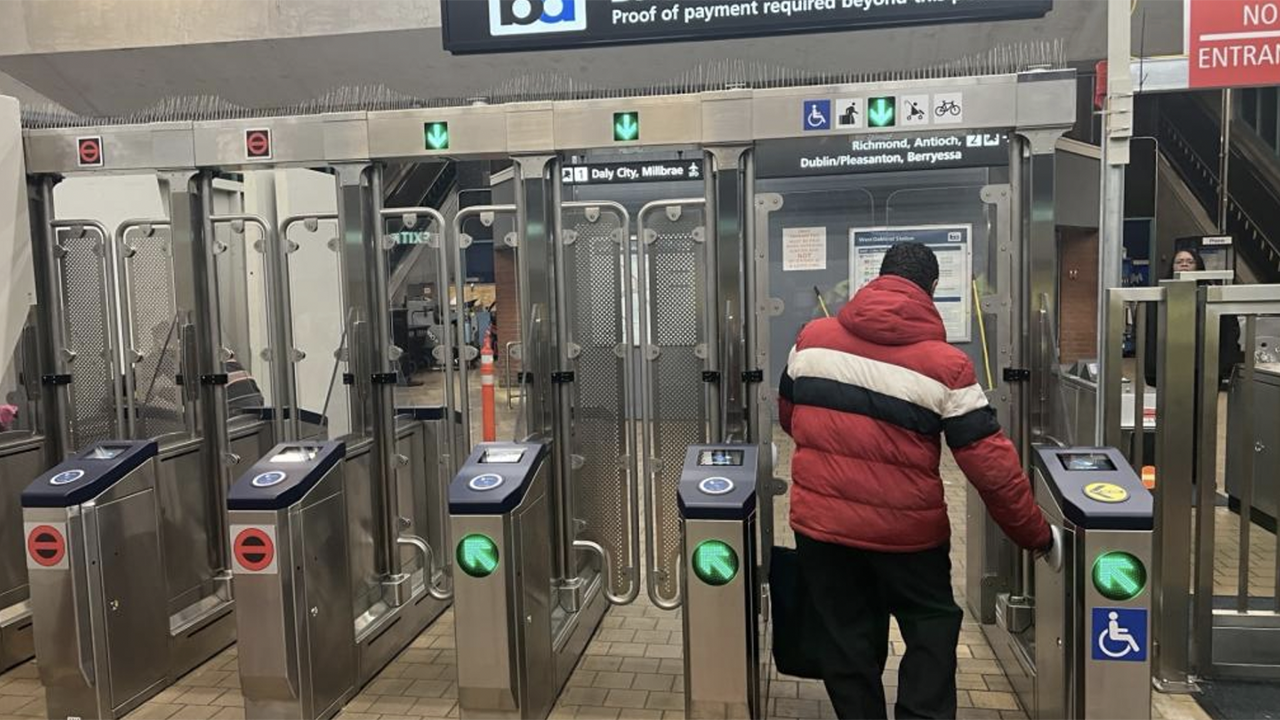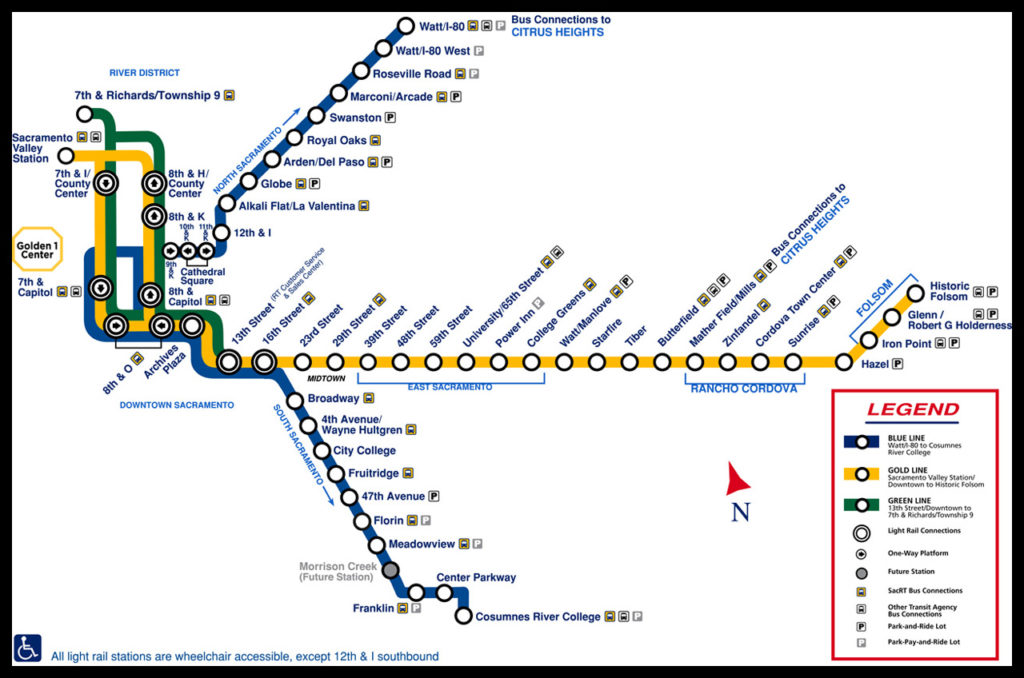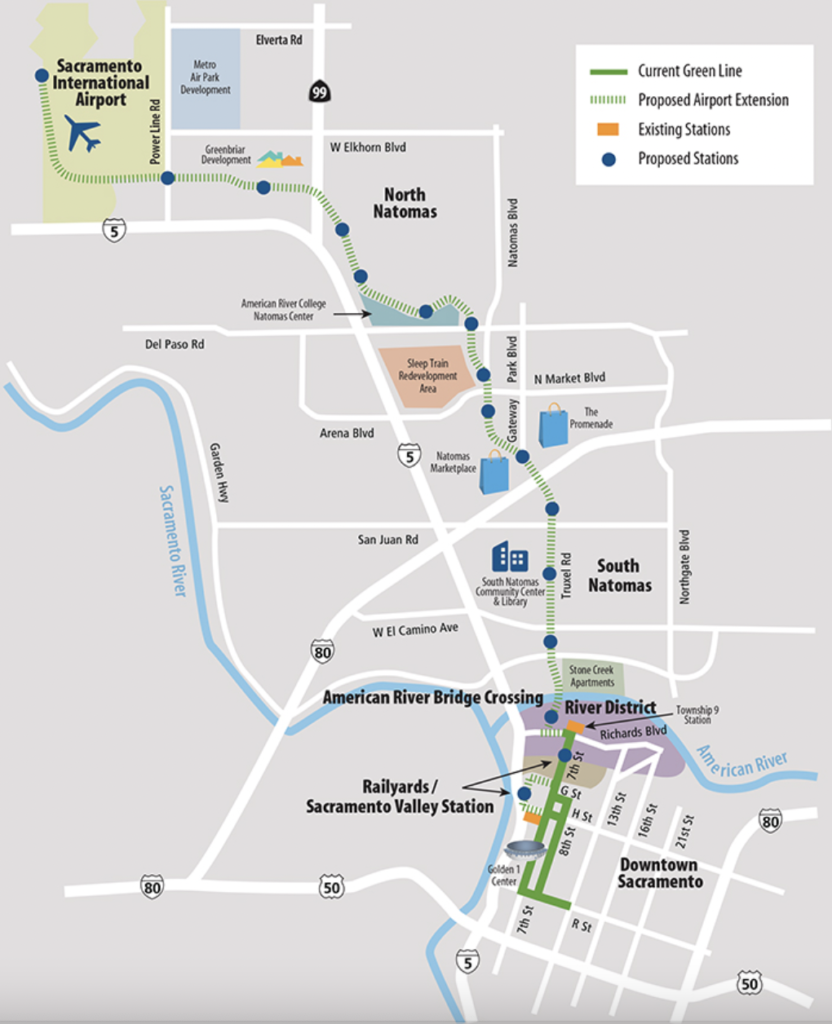
Transit Briefs: NJT, BART, SacRT
Written by Marybeth Luczak, Executive Editor
BART crews have installed prototype fare gates at West Oakland Station to “protect against fare evasion, expand access to transit-dependent riders, and reduce system downtime due to maintenance.” (BART Photograph)
Buses of migrants bound for New York City have been stopping at New Jersey Transit (NJT) stations to avoid New York rules. Also, San Francisco Bay Area Rapid Transit District (BART) unveils prototype fare gates and boosts its “Clipper START” means-based fare discount; and Sacramento Regional Transit District (SacRT) eyes a Blue Line light rail and/or bus rapid transit extension from the city of Sacramento to the city of Elk Grove, supports Sacramento’s Truxel Bridge Concept and Feasibility Study, and lands a Caltrans Climate Adaptation Planning grant.
NJT
Approximately 450 migrants reached NJT stations in Jersey City, Secaucus, Fanwood, Edison, and Trenton, N.J., over New Year’s weekend; they arrived on about 12 buses from Texas and at least one from Louisiana, The New York Times reported Jan. 1.
“The surge in New Jersey arrivals appears to be an end-run around an emergency executive order last week by New York City’s mayor, Eric Adams, requiring charter bus companies to provide 32 hours’ advance notice of the arrival of migrants and restricting the times of day when they can be dropped off,” according to the newspaper.
“They’re using New Jersey essentially as a bus stop to circumvent the limits on buses that can arrive in New York,” Jersey City Mayor Steve Fulop told the Times, “adding that he is not yet concerned about the migrants’ passage through the state.”
According to the Times, there were “chaperones” aboard the buses “who assisted migrants in transferring to trains and buses heading into New York City.” The paper said that Texas Governor’s Office “did not immediately respond to a request for comment,” and a spokesman for the Louisiana Governor “said that while one of the bus companies was based in the state, the migrants aboard the bus came from Texas, and that their office was not involved.”
Railway Age asked NJT for a statement, but an agency spokesman said “[a]ll inquiries on this topic are being handled by the [New Jersey] Governor’s office.”
Tyler Jones, a New Jersey Governor’s office spokeswoman, “said ‘nearly all’ of the asylum seekers arriving by bus had ‘continued with their travels en route to their final destination of New York City,’” and “that the state was ‘closely coordinating’ with local New Jersey officials, the federal government and New York City,” according to The New York Times.
The newspaper reported that Eric Adams “signed his order last week to bring more structure to the process of buses dropping off migrants near the Port Authority Bus Terminal in Midtown Manhattan at odd hours and without notice. The mayor has said the city was being destroyed by the migrant crisis.” According to the Times, New York City hs “processed more than 161,500 asylum seekers [since spring 2022], 68,000 of whom are in shelter and under the city’s care. New York City is required by court decree to provide shelter to those who ask.”
The Times reported that “Texas has sent migrants to cities run by Democrats in an effort to bring attention to the difficulties of states on the southern border and to force President Biden to ‘secure the border,’ the governor’s office has said. Mr. Abbott, a Republican, said he had sent 25,000 migrants to New York City.”
BART
As part of its Safe and Clean Plan, BART on Dec. 28 unveiled prototypes of its new fare gates at the West Oakland Station that are slated to protect against fare evasion, expand access to transit-dependent riders, and reduce system downtime due to maintenance. The transit agency said this is the first time in 20 years that its gates have been upgraded, and it has committed to opening more than 700 new fare gates systemwide by the end of 2025.
Testing of the West Oakland prototypes will primarily focus on door material options. “These are not the final version of the fare gates that will be installed throughout the rest of the system,” BART reported. “The development team will be installing the latest door-braking technology in the coming weeks. This mechanical door lock will be exclusive to BART. No other transit system in the world has it. Once installed, these gates will be harder to push through than any other fare gate in the world.”
The next eight stations to receive the new fare gates will be announced at the Jan. 11 Board of Directors meeting.
“We welcome the new fare gates starting at West Oakland and its future expansion to other stations,” BART Police Chief Kevin Franklin said. “These stronger, higher gates will limit fare evasions through self-enforced fare payments, keep riders safe and engaged to return to BART, and have police officers focused on more serious situations that require emergency services.”
Also, BART on Jan. 1 increased its Clipper START means-based fare discount from 20% to 50%. Clipper START users now pay half the regular BART fare.
Clipper START is a pilot program facilitated by the Metropolitan Transportation Commission (MTC) and offers a discount for Bay Area residents ages 19 to 64 whose incomes are less than 200% of the federal poverty level. Clipper START is accepted by BART and more than 20 other regional transit operators, including Santa Clara VTA, AC Transit, Marin Transit, SolTrans, 3Muni, Sonoma County Transit, Caltrain, Napa VINE, Tri Delta Transit, City Coach, Petaluma Transit, Union City Transit, County Connection, SamTrans, FAST, Santa Rosa CityBus, WestCAT, Golden Gate Transit and Ferry, SMART, and Wheels.
In a related development, the University of California, San Francisco (UCSF) is the first employer to sign up for Clipper BayPass, the Bay Area’s first unlimited regional transit pass, according to BART, which is jointly managing the pilot pass program with the MTC. As of Jan. 1, UCSF’s 6,000 employees can ride free for one year using any of 20-plus transit agency systems.
SacRT

SacRT on Dec. 29 reported on three projects related to transit expansion and climate change impacts. In partnership with the city of Elk Grove, Calif., the agency has received a $470,000 Caltrans Climate Adaptation grant for the conceptual design and further planning of an extension of the Blue Line light rail and/or bus rapid transit from the city of Sacramento to the city of Elk Grove. According to SacRT, this project encompasses an existing conditions report, alignment and station location recommendations, ridership projections, technical analysis, traffic modeling, and station area plans.
The collaboration, which is supported by the Sacramento Area Council of Governments (SACOG), “will engage various stakeholders and involve extensive community participation, ensuring that the project aligns with the needs and aspirations of the community,” SacRT said .

Also, SacRT reported that the city of Sacramento is undertaking an engineering feasibility study for a new multi-modal bridge across the lower American River between Truxel Road and Sequoia Pacific Boulevard “to better connect North and South Natomas with the Central City.”
SacRT said it is providing “internal technical review/support for this plan resulting in forward movement of the Green Line extension project” (see map, left). The Green Line project will extend light rail approximately 13 miles north from downtown Sacramento to the River District, the Natomas communities and the Sacramento International Airport, as outlined in SACOG’s MTP/SCS.
According to the city of Sacramento, there is currently a lack of direct multi-modal crossings over the American River, “which discourages alternative modes of travel besides driving, therefore resulting in higher greenhouse gas emissions, higher vehicle miles traveled (VMT) due to longer trips, inefficient routes for transit services, and reduced public health and air quality.” This limited connectivity, the city reported, “leads to longer emergency response times and can hinder evacuation during future natural disasters.”
The purpose of the study “is to refine the adopted alternative for the new bridge by conducting an inclusive public outreach and engagement process in collaboration with the detailed engineering and environmental analysis,” according to the city. “The neighboring communities, including the priority populations who have been historically under-represented, as well as the larger public will be engaged through community-based engagement to ensure the bridge fits within the context of the existing communities and serves the needs of the community. The project team will gather feedback on bridge configuration concepts, constraints analysis and design drawings. A few of the key elements that will require stakeholder input include avoidance of known constraints, minimizing impacts to the Lower American River and associated wildlife, configuration of right-of-way on the bridge for all modes of travel, and connections to existing bicycle and pedestrian pathways.”
SacRT reported that the Conceptual Plan for the Truxel Bridge is being funded by a Caltrans Sustainability grant obtained by the city of Sacramento in partnership with SACOG and supplemented by local funds from SacRT and developer fees. According to the city of Sacramento, the overall cost of the Truxel Bridge, which is expected to exceed $500 million, is to be funded through a combination of Infrastructure Investment and Jobs Act and other federal funds; the Road Repair and Accountability Act (SB1) and other state of California funds; and a variety of local funding sources, including a future transportation sales tax and developer impact fees.
Lastly, SacRT reported that in a collaboration effort with the city of Sacramento, a Caltrans Climate Adaptation Planning grant for $730,209 was secured “to address the impacts of climate change.” According to the transit agency, the project involves a “comprehensive multi-hazard risk assessment of transportation systems, the development of adaptation solutions, and the creation of a prioritized list of transit projects using a multi-criteria analysis.” The initiative will ultimately lead to the integration of climate change adaptation strategies into the capital improvement process, providing both the city and SacRT “with actionable efforts to reduce climate change impacts on our transportation infrastructure,” the transit agency said.


